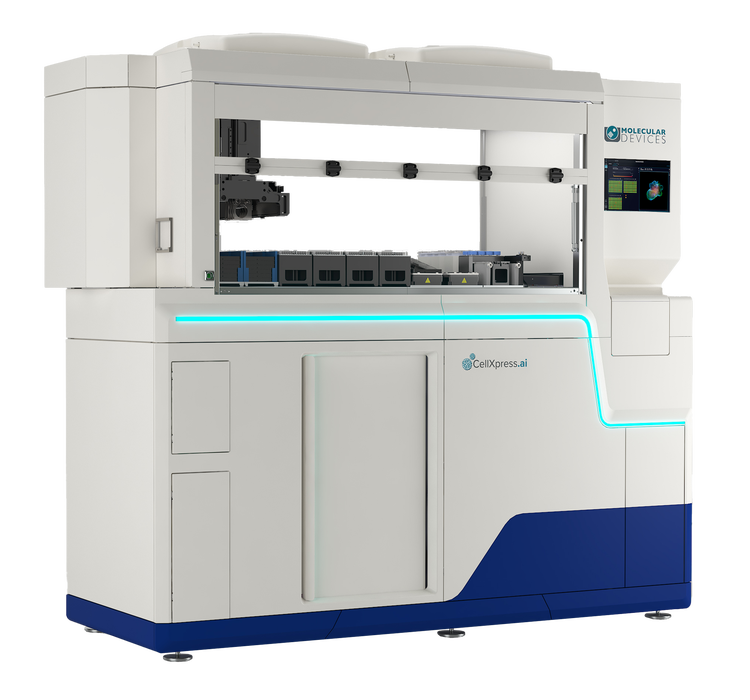AI in Phenotypic Drug Discovery

Introduction to AI in Phenotypic Drug Discovery
Phenotypic drug discovery involves identifying drug candidates based on their observable effects on cells and tissues, rather than investigating their impact on a targeted molecular pathway. This approach allows researchers to uncover unexpected mechanisms of action and novel therapeutic targets.1
Target-based drug discovery has dominated the pharmaceutical landscape, relying on a linear target-drug model. While effective in some cases, it often overlooks the complex biological interactions, spatial organization and morphological changes in cells that influence disease progression and treatment response.2
Phenotypic screening in drug discovery relies on cutting-edge image acquisition and analysis. Therefore, imaging workflows must be executed with utmost care and precision. To that end, the integration of artificial intelligence (AI) can provide immense value by automating image analysis, detecting subtle phenotypic changes and uncovering hidden correlations across image datasets. AI enables faster and unbiased screening, ultimately guiding hit identification and reducing development timelines.3
AI-driven phenotypic screening is poised to complement target-based drug discovery, thereby improving confidence in the efficacy and safety of novel drug candidates.2

CellXpress.ai Automated Cell Culture System
The future of cell culture backed by machine learning and data-driven science.
Why Phenotypic Screening Matters in Drug Discovery
Phenotypic screening in modern drug discovery focuses on how compounds alter observable cellular traits such as cell morphology, viability or signaling activity. Instead of quantifying the impact of a drug on a target molecule, researchers identify hits by measuring their overall biological effects, making this approach ideal for unveiling multifaceted mechanisms of action. Through phenotype-driven drug candidate identification, scientists can discover and refine therapeutic molecules that act on previously unknown pathways involved in phenotypic outcomes, such as growth, proliferation, calcium signaling and survival.2
It is important to distinguish between phenotypic drug screening and phenotypic drug discovery. The former refers specifically to the experimental process of testing compounds for phenotypic effects, while phenotypic drug discovery encompasses the entire pipeline, from screening and hit validation to lead optimization.4
The Role of AI/ML in Phenotypic Drug Discovery
Through artificial intelligence and machine learning (AI/ML), researchers can analyze multidimensional biological data with greater accuracy and speed. While manual data analysis in traditional phenotypic screening is time-consuming and prone to bias, AI-powered phenotypic drug discovery streamlines the process, enhancing efficiency and reducing bias. It also reveals subtle differences in phenotypic outcomes, which researchers might overlook during subjective analysis.4
Machine learning in phenotypic screening leverages algorithms that learn from imaging data to recognize cellular signatures linked to therapeutic potential. In particular, advanced deep learning models and neural networks can help extract essential features from microscopy images and high-content datasets, making multidimensional image datasets more interpretable and organized.3
Screening Techniques and Phenotypic Assays
High-Content and High-Throughput Phenotypic Screening
High-content screening (HCS) is a cornerstone of phenotypic drug discovery, combining automated microscopy with image analysis to capture multiparametric data from cells. Researchers use HCS to measure hundreds of cellular features simultaneously, including morphology, organelle structure and signaling dynamics.5
Phenotypic screening can be automated to evaluate large compound libraries more swiftly. Furthermore, multiparametric phenotypic screening enhances the accuracy and sensitivity of phenotypic classification, allowing for the distinction of subtle differences in cellular responses.6
Image-Based and Cell Painting Assays
Image-based phenotypic screening plays a vital role in drug discovery by converting cellular images into quantifiable data for computational analysis. At the core of this screening method is cell painting, which utilizes multiple fluorescent dyes to stain distinct cell components. Furthermore, AI-driven image processing helps deduce correlations between phenotypic signatures and drug efficacy or toxicity.7
Translational and Advanced Phenotypic Models
Advanced cell models, such as organoids and 3D cultures, more accurately mimic real tissue environments than 2D models, making them ideal for phenotypic assays. These translational phenotypic models offer more physiologically relevant data, bridging the gap between in vitro screening and in vivo drug response, ultimately paving the way for clinical translation and success rates.8
Benefits of AI-Powered Phenotypic Drug Discovery
AI/ML-driven phenotypic screening confers several advantages to drug discovery pipelines.4
- Increased Success Rate: AI algorithms make image analysis more unbiased, improving hit quality and mitigating late-stage failures
- Faster Drug Discovery: AI can accelerate screening workflows by automating high-content imaging and data processing, shortening the time from hit identification to lead optimization
- Broader Target Diversity: AI-powered phenotypic screening helps researchers explore novel drug interactions within the cell, broadening therapeutic possibilities for diseases driven by multiple mechanisms
- Novel Mechanism Identification: Through deep learning and neural networks, AI infers correlations between molecular interactions and observed phenotypes, strengthening mechanism-of-action (MoA) discovery for precision medicine
Applications of AI in Phenotype-Based Drug Discovery
AI enhances various stages of phenotypic drug screening and phenotype-driven drug discovery by enabling researchers to analyze complex cellular responses with greater speed, accuracy and reproducibility.
Automated Image Analysis
AI algorithms, particularly deep learning models, can process massive collections of microscopic images from high-throughput phenotypic assays. These models detect minuscule morphological variations in drug-treated cells that escape human observation, improving accuracy, reproducibility and overall screening throughput.9
Phenotype Classification and Mode of Action (MoA) Prediction
AI algorithms can analyse image data to accurately classify phenotypes among a set of heterogeneous cells and drug response profiles. Thus, it can infer correlations between drug-induced perturbations and cellular behaviour and structure, providing rich insights into mechanisms of action for each phenotype.3
High-Throughput Screening (HTS) Enhancement
AI drives high-throughput screening by accelerating data processing, pattern recognition and hit identification. Thus, it shortens timelines and reduces variations across different screening runs.10
Novel Compound Design
Generative models search vast collections of compound libraries to propose novel molecular structures that promote desired cellular changes. They can also be used to filter compounds most likely to yield responsive phenotypes. Overall, researchers become better-informed and prepared for lead optimization.3
Integration with Microfluidics and Organ-on-a-Chip (OOC)
An organ-on-a-chip is a type of advanced model that simulates organ functioning and interactions with the physiological environment at a microscale, allowing for precise control over cell culture environments, nutrient flow and drug exposure. AI algorithms can process the stream of data from OOC-integrated phenotypic assays, revealing the effects of dosing and drug interactions on tissue integrity, metabolism and functional activity in real-time. The insights gained from AI-driven phenotypic screening with OOCs are more translatable to clinical outcomes than those from traditional 2D cell assays.11
Drug Repurposing
Researchers can also use phenotypic screening to explore novel therapeutic applications of approved drugs. The combination of cell painting assays, high-content imaging and multi-omics studies helps establish connections between drug interactions and morphological changes. AI systems can identify known drugs that unexpectedly produce therapeutic responses across different disease models. Furthermore, AI analytics can give a realistic overview of the drug repurposing potential by combining phenotypic outputs with data from diverse sources, including clinical trials, biomedical literature, gene expression databases and real-world evidence.12
Personalized Medicine & Functional Genomics
By merging patient-derived phenotypic data with multi-omics profiles, AI supports precision medicine strategies that forecast individual drug responses. This approach strengthens functional genomics by linking genetic variation to observable phenotypic effects, driving more targeted and effective therapies.13
Challenges and Ethical Considerations
The adoption of artificial intelligence in phenotypic drug discovery offers immense promise but also introduces new scientific, technical and ethical challenges. Only by understanding these limitations can researchers ensure reliability, transparency and clinical applicability.
Scientific and Technical Challenges
One of the significant hurdles in AI-powered phenotypic drug discovery is validating AI predictions. While machine learning and deep learning models can identify distinct cellular patterns and predict drug effects, their outputs must be experimentally verified to confirm biological relevance.14
Interpretability is another challenge and, in fact, a disadvantage of AI-driven phenotypic screening over human-informed screening. Deep learning algorithms often operate as black boxes, making it difficult to explain the logic behind phenotypic classification and feature extraction. Furthermore, variability, overrepresentation or underrepresentation in image data can limit the generalizability of AI models across different cellular image datasets.14
Regulatory and Ethical Dimensions
As AI continues to dominate phenotypic drug discovery and clinical development, regulators face increasing pressure to define standards for AI transparency, data governance and traceability. In addition, regulators should address ethical concerns surrounding data privacy, informed consent in patient-derived studies and the responsible use of predictive models.15
Establishing ethical frameworks and regulatory guidelines for AI-driven drug discovery will be crucial for ensuring that scientific innovation aligns with patient safety, fairness and public trust.
See how Danaher Life Sciences can help
FAQ's
How does AI compare to classical phenotypic screening methods?
AI offers faster, more objective and data-rich analysis than traditional manual screening. It detects subtle cellular changes that human observation may overlook, improving accuracy and throughput.
What is the difference between target-based and phenotypic drug discovery?
Target-based discovery focuses on a specific molecular target, while phenotypic drug discovery identifies compounds based on observable biological effects without prior knowledge of a target.
How does AI improve the accuracy of phenotypic screening?
AI algorithms analyze thousands of cellular features simultaneously, reducing human bias and variability and improving reproducibility in screening results.
What AI methods are best suited for complex phenotypic image analysis?
Deep learning and convolutional neural networks (CNNs) excel at processing high-content images, recognizing intricate phenotypic patterns.
How is AI applied in phenotypic screening workflows?
AI supports image segmentation, phenotype classification, hit selection and mechanism-of-action prediction throughout the drug discovery pipeline.
References
- Vincent F, Nueda A, Lee J, Schenone M, Prunotto M, Mercola M. Phenotypic drug discovery: recent successes, lessons learned and new directions. Nat Rev Drug Discov 2022;21(12):899-914.
- Tauro S, Dhokchawle B, Nahar D, Nadar S, Thakor E, Mohite P. Target-based vs phenotypic drug discovery: opportunities and challenges with evidence-based application. Drug Discovery Stories 2025:25-45.
- Krentzel D, Shorte SL, Zimmer C. Deep learning in image-based phenotypic drug discovery. Trends Cell Biol 2023;33(7):538-554.
- Malandraki-Miller S, Riley PR. Use of artificial intelligence to enhance phenotypic drug discovery. Drug Discov Today 2021;26(4):887-901.
- Hughes RE, Elliott RJ, Dawson JC, Carragher NO. High-content phenotypic and pathway profiling to advance drug discovery in diseases of unmet need. Cell Chem Biol 2021;28(3):338-355.
- Boivin B, Roet KC, Huang X, Karhohs KW, Rohban MH, Sandoe J, et al. A multiparametric activity profiling platform for neuron disease phenotyping and drug screening. Mol Biol Cell 2022;33(6):ar54.
- Seal S, Trapotsi M-A, Spjuth O, Singh S, Carreras-Puigvert J, Greene N, et al. Cell Painting: a decade of discovery and innovation in cellular imaging. Nat Methods 2025;22(2):254-268.
- Escopete S, Arzt M, Mozneb M, Moses J, Sharma A. Human cardiac organoids for disease modeling and drug discovery. Trends Mol Med 2025.
- Sexton JZ, Fursmidt R, O’Meara MJ, Omta W, Rao A, Egan DA, et al. Machine learning and assay development for image-based phenotypic profiling of drug treatments. AGM [Internet] 2023.
- Pham T-H, Qiu Y, Zeng J, Xie L, Zhang P. A deep learning framework for high-throughput mechanism-driven phenotype compound screening and its application to COVID-19 drug repurposing. Nat Mach Intell 2021;3(3):247-257.
- Liu J, Du H, Huang L, Xie W, Liu K, Zhang X, et al. AI-powered microfluidics: shaping the future of phenotypic drug discovery. ACS Appl Mater Interfaces 2024;16(30):38832-38851.
- Tanoli Z, Vähä-Koskela M, Aittokallio T. Artificial intelligence, machine learning, and drug repurposing in cancer. Expert Opin Drug Discov 2021;16(9):977-989.
- Dingemans AJ, Hinne M, Truijen KM, Goltstein L, van Reeuwijk J, de Leeuw N, et al. PhenoScore: AI-based phenomics to quantify rare disease and genetic variation. Nat Genet 2023;55(9):1598.
- Niazi SK. The coming of age of AI/ML in drug discovery, development, clinical testing, and manufacturing: the FDA perspectives. Drug Des Devel Ther 2023:2691-2725.
- Mirakhori F, Niazi SK. Harnessing the AI/ML in drug and biological products discovery and development: the regulatory perspective. Pharmaceuticals 2025;18(1):47.